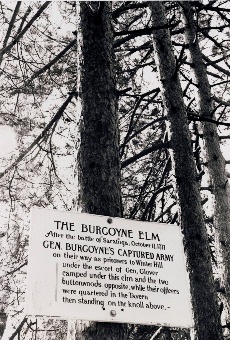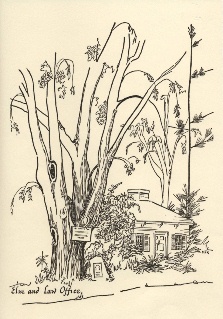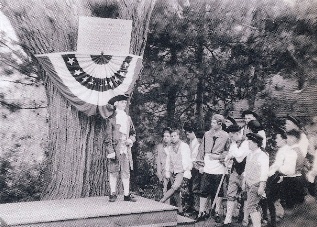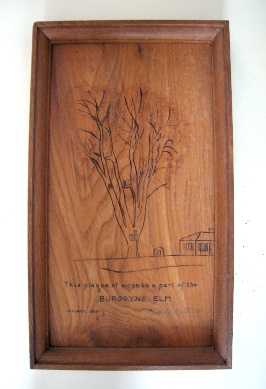Click on the images to enlarge them.

The Burgoyne Elm historical marker is now affixed to a pine tree. (1990 photo)

Peg Kronenberg's drawing for Emma Ripley's book Weston: A Puritan Town.

Line drawing by Henry Davenport for Frontispiece in Brenton Dickson III's book Once Upon a Pung.

The Burgoyne Elm was a focal point for events at Weston's 250th Anniversary in 1963.

An unknown artist created this portrait of General John Burgoyne from the wood of the Burgoyne Elm.

This plaque was made by Harold Stevens from the wood of the Burgoyne Elm.
The Burgoyne Elm
“The story of the Burgoyne Elm . . .goes far beyond its shadow.
This great tree has spanned the years between Revolutionary times and the present,
standing today as a symbol of liberty and a memorial to an important epoch in the history
of our country.”
Brenton H. Dickson III, 1967
Who was Burgoyne?
General John Burgoyne was the British general defeated by General
Gates at Saratoga on October 17, 1777. This battle marked a turning point in the American
Revolution. Click here
to view John Trumbull's 1821 painting of the Surrender of General Burgoyne. After the battle, the
British signed the “Saratoga Convention” which stated that captured soldiers were technically
not prisoners and were to be returned to Europe on the condition that they would never fight
in North America again. The job of escorting the weary British, German, and Hessian soldiers
to Somerville pending their embarkation was given to General Glover of Marblehead. The journey
took about three weeks.
American troops and their captives suffered many hardships as they traveled along nearly
impassible roads and crossed the Taconic Range in a heavy snowstorm. They left destruction
in their wake, burning fences, destroying crops, and robbing houses. Little effort was spent
in finding sleeping quarters for the enlisted men in either army. In contrast, Burgoyne,
Glover, and other officers were entertained at fine houses along the way.
What was the Burgoyne Elm?
The Burgoyne Elm was a large elm tree that stood on the south side of Boston Post Road just east of the Fiske Law Office. Until the death of the tree in 1967 and its removal in stages over subsequent decades, the elm was a patriotic symbol venerated by local history enthusiasts for its age and link to the War of Independence.
What happened when Burgoyne's army passed through Weston?
The poorly disciplined hordes, estimated to number in the thousands,
arrived in “Westown” on November 6. The British officers were housed at the Golden Ball
Tavern and the Americans at Baldwin's Tavern, which was located west of the present Fiske
Lane. The American troops and their prisoners camped overnight wherever they could, some in
the shelter of what became known as the Burgoyne Elm. It reportedly took weeks to clean up
and restore order after their departure the following day.
The captured soldiers finally arrived in Boston but were not allowed to return to England.
The Continental Congress suspected that the British would send them back into action.
After a hard winter in Cambridge and Somerville, they were marched to a prison camp in
Virginia and later to Pennsylvania, where they were finally released after the surrender
of Lord Cornwallis.
Why did this and other elm trees become patriotic symbols?
In his book The Republic of Shade, Thomas J. Campanella writes that
“no tree loomed larger in American history” than the American elm. During the colonial
period, elms took root in public squares, where historic events took place under their
spreading branches. According to Campanella, New Englanders felt the loss of their European
connections and turned to the American elm—a native tree—to bolster their identity. The trees
were often the oldest objects around and were redefined as beloved witnesses to important
historical events. Our exhibit includes a piece of the “Washington Elm” which stood in the
Cambridge Common and was venerated as the place where George Washington took command of the
American Army on July 3, 1775.
By the late 19th century, the elm had become a regional icon. Its uplifting branches were
seen as a symbol of Yankee rectitude. The trees were systematically planted throughout
New England as part of the village improvement movement.
What celebrations have taken place under the Burgoyne Elm?
In 1932, Weston residents turned out to welcome a cavalcade on the
first leg of a 115-mile trek commemorating George Washington's 1789 journey through New
England. Beneath the Burgoyne Elm, the costumed general greeted ladies in colonial gowns and
gentlemen in long velvet coats and three-cornered hats. Local dignitaries presented state
officials with a bronze plaque that was affixed to a huge boulder under the spreading elm.
This plaque is now in storage.
The Burgoyne Elm was a focal point again in 1963, at the town's 250th Anniversary
celebrations. At that time the age of the tree was estimated to be 300 years old. After it
was cut down, the elm's age was calculated to be 225 years (c.1742-1967).
When was the Burgoyne Elm taken down?
By the 1960s, the Burgoyne Elm, like others of the species throughout
the country, had succumbed to Dutch Elm Disease. On August 21, 1967, the limbs were cut off,
leaving a mammoth trunk 18 feet high and 25 feet around the base. The Weston Historical
Society searched for a way to preserve the trunk from deterioration. Three heavy steel bands
of strapping kept the trunk together for a time. Inquiries to chemical, horticultural, and
mechanical experts yielded no solutions.
Dr. Donald Wyman of the Arnold Arboretum propagated healthy scions to try to ensure that
there would “always be a Burgoyne Elm in Weston.” Unfortunately, none of these sons and
daughters are known to have survived.
At the time of the nation’s Bicentennial in 1976, the trunk was cut down to a height that
would allow important historical dates to be burned into the elm's age rings. For its
Bicentennial project, the Weston Rotary, under president Bruce Nickerson and his son Andrew,
took on the work of counting rings and locating the dates at the appropriate intervals on the
preserved bole. A large section of the elm has been preserved at the Weston Historical Society.
The Burgoyne bole proved difficult to protect from the effects of weather and insects, and it
was eventually removed.
What happened to the wood of the Burgoyne Elm?
After the limbs of the tree were removed in 1967, a “Project Burgoyne
Elm” committee was formed, comprised of Howard Forbes, Mrs. Daniel F. Viles Jr, and Galen
Green. Their task was to supervise the utilization of the wood and the making of souvenirs
by students in the Industrial Arts Department of the Junior and Senior High Schools. The first
Weston Historical Society awards for excellence were made at graduation in June 1968. First
prize for junior high students went to Christopher Arthur Larsen for the “Monk’s Chair,” and
honorable mentions were presented to William Grant (Lazy Susan), David Farrell, Jr.
(spoon rack), and Michael Zerpolo (hanging clock). The intent of the Society was to hold the
competition annually. The Society would be grateful for information about other examples.
Click here to link to the article entitled,
“The Burgoyne Elm: Do We Still Care?” on page 25 of the Spring, 2009 issue of the
Weston Historical Society Bulletin.
Click here to see a timeline spanning
more than two centuries and noting the most significant historical events related to the Burgoyne Elm.
For further information see the following articles in
The Weston Historical Society Bulletin:
Brenton H. Dickson III, “The Burgoyne Elm,” May, 1967, p. 3-5
May, 1968, p. 3
October, 1968, p. 5
Harold G. Travis, “Our Historic Burgoyne Elm and Its Memories,” October, 1971, p. 1-2, 4
May, 1975, p. 1, 4
Harold G. Travis, “Hallmarks and Landmarks of Weston,” May, 1977